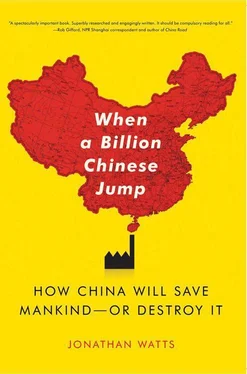The natural wealth of Tibet was one reason that the region’s Chinese name is Xizang, or “western treasure house.” While road and air were the only forms of transport, it had not been economical to extract or develop these resources. But this would change with the Sky Train.
Minerals also became easier to exploit as the Sky Train cut freight charges by 75 percent, according to the railway ministry. With global commodity prices surging as a result of the growing demands of China’s factories, miners could suddenly see the potential for profit in Tibet’s mountains. A Gansu fluorite miner explained to me that Tibet and Mongolia were the future for his business because reserves elsewhere were fully exploited, while the train made it cheaper to mine on the plateau.
With the transport ministry planning six more lines on the plateau by 2020, 32more of the mineral wealth of Tibet is likely to be freighted to the eastern seaboard. The story of Yugong Yishan is coming closer to being realized. Mountains are being moved, freight car by freight car.
Hydropower is another resource that will probably be developed. The Tibetan Plateau is the water tank of the continent, the source of the Yangtze, Mekong, Yellow, Salween, Brahmaputra, Indus, and Ganges, and other mighty rivers that slake the thirst of at least two billion people who live downstream. 33Until recently it had relatively few dams, though some, such as the one at Yamdrok Tso, are major barriers. Tibetans considered them a defilement of sacred lakes and rivers. The prospect of local opposition and high cost of working in remote areas held back development of other areas. The railway weakens those barriers by making it cheaper and easier to move engineers, materials, and the troops to guard them. The government’s plans for new dams, such as the giant 40,000-megawatt plant at the bend of the Yalong Zangbo (Brahmaputra) and water diversion projects threaten the environmental security of South Asia. 34
We stayed overnight in a grimy truckers’ lodge. Over dinner at the Chengdu First Class Restaurant, I was too tired by the journey and the 4,500-meter altitude even to chat. We had reached the place where China’s can-do spirit, the essence of Peak Man, pushed people and the environment to the limit. But the population was swelling here too.
Close to the southern bank of the river, new homes had been built for Tibetan nomads relocated from the plains. There were also fresh residents at the local weather-monitoring station, where three recent graduates had just arrived from their urban homes on the coast. They had already noticed the impact of climate change in their measurements. The cold season in Tuotuohe now began in early October, instead of late September. The rise in temperature was prompting different avalanche patterns.
But the graduates’ more immediate concern was how to pass three years in the middle of nowhere. “We play mah-jongg and I’ve started fishing,” said one young scientist. “We’ll have to be imaginative or we’ll die of boredom here.”
Many other migrants were having to adjust. Demographic changes follow railways. 35The number of tourists visiting the Tibet Autonomous Region more than doubled to 4 million within two years of train services to Lhasa. The government was encouraging further migration. As part of its “Go West” policy to develop inland regions such as Tibet, the government encouraged college graduates to take jobs in target regions by refunding their tuition fees. 36This was part of an influx that affected the environmental and social order. A major cause of the deadly ethnic riots in Lhasa of 2008 was anger among the local population at Han and Hui migrants who dominated business in the center of the city.
Beijing’s politburo of engineers would never accept a challenge to their control over Tibet. The strategic value of this highest of high ground was simply too great. The unrest was quelled. Government spokesmen accused the Dalai Lama of being “a wolf in monk’s clothing.” The colonization of the mountains was once again portrayed in the state media as a benevolent act of development. I recalled Younghusband, who also believed he was bringing civilization to Tibet by making its resources exploitable. He left Lhasa “boiling over with love for the whole world” just weeks after ordering the slaughter of any Tibetan who stood in his way. 37The Chinese government was less murderous but more effective in exercising control in the name of progress.
In Tuotuohe, my head was pounding. The altitude was taking its toll. I had thrown up once. A bag of oxygen offered only temporary respite. Ahead was another vast barren plain, then the towering peaks of the Tanggula range, which marked the border with Tibet. The railway stretched forward, but for me it was the end of the line. Thinking back over what I had seen on the roof of the world, and what I had read of imperial and industrial history, I jotted down a line in my notebook: “In the nineteenth century, Britain taught the world how to produce. In the twentieth, the US taught us how to consume. If China is to lead the world in the twenty-first century, it must teach us how to sustain. ”
But how could it do so when the foolish mountain movers prevailed over the useless-tree philosophers? Those who quested for power overcame even the wisest of those who were content to sustain.
Returning on the road we had come, our car passed a long convoy of military trucks heading toward Lhasa. The clouds, now dark and heavy with rain, sagged down almost to the plateau. A mass of brightly colored Tibetan prayer flags fluttered on the banks of a small river that would swell downstream to become the mighty Yangtze.
We passed over it on Mu’s concrete road beside Hu’s iron rail. Generations after Mao, the old chairman’s dream was being realized. Man was asserting its will over the mountains. As I was to learn farther downstream, the same was true of the rivers. Human ambition did not get much greater. Nor did the consequences.
3. Still Waters, Moving Earth
Sichuan
Walls of stone will stand upstream to the West
To hold back Wushan’s clouds and rain
Till a smooth lake rises in the narrow gorges.
The mountain goddess if she is still there
Will be shocked at a world so changed.
—Mao Zedong, anticipating the Three Gorges Dam in his 1956 poem “Swim”
The cracked and shaken dam was safe. That was what the engineers said. But I could not help feeling a twinge of anxiety riding on the back of a motorbike toward the 156-meter-high slab of concrete that was holding back the Min River.
Four days had passed since China’s most devastating earthquake in more than thirty years struck just a short distance upstream, wobbling the earth, reshaping mountains, and tearing chunks off the dam’s concrete skin. The repair work continued. So did the aftershocks. As I drew closer, a cascade of water thundered through the floodgates above my head, covering me in a fine mist. Pressure from the reservoir on the other side of the barrier was being hastily released.
Half as tall again as the better-known barrier at the Three Gorges, Zipingpu was one of the newest and biggest of China’s 87,000 dams. 1But it was not designed to withstand an almost direct hit by a magnitude 8 earthquake. 2
Within seconds of that temblor, death and destruction rippled across an area the size of Belgium. More than ten million man-made structures came crashing down, landslides swallowed entire villages, 4 million people were instantly homeless, and tens of thousands of people were buried alive. The toll of dead and missing from that single minute of instability would eventually rise above 87,000.
In the chaotic aftermath of the quake, the government’s biggest concern was that a major dam might give way. 3Sichuan, a province of high mountains and mighty rivers next to the Tibetan Plateau, has more of these barriers than anywhere else in China. 4But Zipingpu was in a fear category of its own. Perched above the densely populated city of Dujiangyan, the dam was all that stood between 110 million cubic meters of water high in the mountains and 600,000 dwellers on the plains below. The juddering had opened fissures at the top of the dam, distorted the base, and put two floodways out of action. The state-run Xinhua News Agency described the cracks as “extremely dangerous.” 5If the dam collapsed, the death toll from the earthquake could easily multiply severalfold.
Читать дальше










